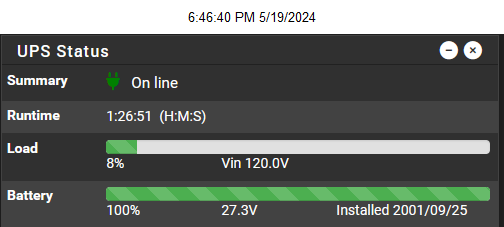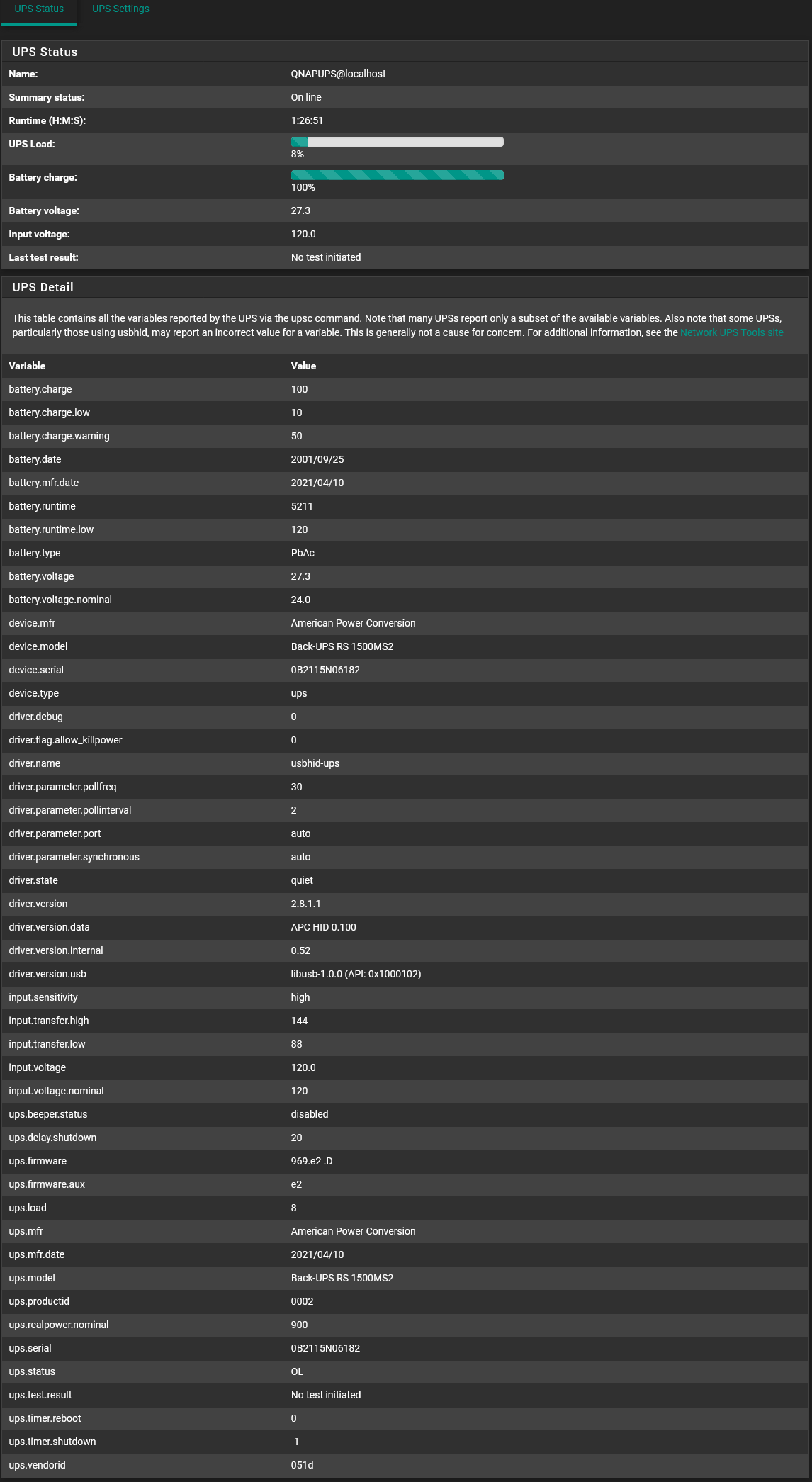NUT dashboard widget
-
@dennypage Wow! Didn't expect it that fast. Love it! Is there any way to display when and why UPS went to battery last time?
Thanks for making this.
-
@FrankZappa Also, I really like the colors to make it pop in the dashboard. If the battery is not charged to 100% does the bar graph change to yellow, and maybe once it gets down to 50% can it turn red? Just thought it would look cool (not that I want my battery to ever get down to 50%). Thanks
-
@FrankZappa Mine is showing the wrong battery date and I don't have the last test. Other than that, it looks great.

-
@FrankZappa said in NUT dashboard widget:
Wow! Didn't expect it that fast. Love it!
Glad you like it. I had some time...
@FrankZappa said in NUT dashboard widget:
Is there any way to display when and why UPS went to battery last time?
I don't believe this is reported. I have a fairly high end APC, and I don't have it. Best alternative is enabling notifications and then you'll get a real-time notification of transfers.
@FrankZappa said in NUT dashboard widget:
I really like the colors to make it pop in the dashboard. If the battery is not charged to 100% does the bar graph change to yellow, and maybe once it gets down to 50% can it turn red?
The battery bar is red below 50%, yellow below 75%, otherwise green. Same for the summary icon, which shows plug, battery (with levels), and unknown. Even if the UPS is on line, if the UPS reports that the battery needs replacing, or if the UPS is overloaded, the plug icon will remain red.
The load bar is green below 95%, yellow below 99%, and red above.
@FrankZappa said in NUT dashboard widget:
Mine is showing the wrong battery date and I don't have the last test.
The 2001/09/25 date kinda looks like a "never been set" value. Look for "battery.date" in Services / UPS / UPS Status. This is what is reported to/by NUT. What do you see there?
For test info, look for "ups.test.date" and/or "ups.test.result" in Services / UPS /UPS Status. Are these being reported by the UPS to NUT?
-
@dennypage Thanks dennypage. Here's a screenshot of everything I have.

-
I'm not sure what "battery.date" is really meant to be, but it reads as 2001/09/25 on my APC UPSes too. Maybe it identifies the age of the design? Anyway, these fields seem considerably more plausible as the real age of the one I'm looking at:
battery.mfr.date: 2022/04/13
ups.mfr.date: 2022/04/13 -
@dennypage said in NUT dashboard widget:
For test info, look for "ups.test.date" and/or "ups.test.result" in Services / UPS /UPS Status. Are these being reported by the UPS to NUT?
A field like "ups.test.date" could only get populated accurately if the UPS contains an RTC. I've owned a lot of UPSes over the years, and never seen any indication that they have settable clocks. The date fields they do output all look like burned-in-at-the-factory values.
-
@FrankZappa So, your battery date really does show as 2001/09/25. I believe this means that it was not set at the factory. Looks like the apcupsd widget was reporting the UPS manufacture date rather than the battery install date.
To set the battery date, you can (hopefully) use upsrw.
Use
upsrw -l UPSNAMEto see what variables you can write in the UPS. The variable you are looking for is "battery.date".
Your "ups.test.result" shows that no self test has been run on the UPS. For higher end APC UPSs, this is done by automatic timer. For lower end UPSs, you have to trigger it manually. If you do that, you will have to write the test date yourself--look for variable "ups.test.date" in the upsrw output.
-
@tgl said in NUT dashboard widget:
I'm not sure what "battery.date" is really meant to be, but it reads as 2001/09/25 on my APC UPSes too.
See note above. It just means that it wasn't set at factory or at the point of initial install (which requires a UPS that has time capability).
If the UPS doesn't have time capability, then you are responsible for maintaining this field by hand when you initially install and/or change batteries.
If your UPS has a network management card, this would be handled automatically. My current APC is like this.
-
@FrankZappa Forgot to mention. To run a self-test, would use upscmd. To see a list of commands the UPS will accept, use:
upscmd -l UPSNAMEMost likely, the command will be:
upscmd UPSNAME test.battery.start -
@dennypage said in NUT dashboard widget:
See note above. It just means that it wasn't set at factory or at the point of initial install (which requires a UPS that has time capability).
On mine, it's not settable period. "upsrw -l" claims to be able to set "battery.mfr.date", but not any other kind of date.
-
@tgl What brand/model?
FWIW, "ups.mfr.date" is a standard field, but I don't recall ever seeing "battery.mfr.date"
-
@dennypage
APC Back-UPS Pro BR1500MS2 -
@tgl Please post Services / UPS / Status.
-
@dennypage said in NUT dashboard widget:
@tgl Please post Services / UPS / Status.
I don't actually have NUT installed on my router (yet); this UPS is connected to a Linux server. "upsc" reports what I suppose you want:
battery.charge: 100 battery.charge.low: 10 battery.charge.warning: 50 battery.date: 2001/09/25 battery.mfr.date: 2022/04/13 battery.runtime: 4152 battery.runtime.low: 120 battery.type: PbAc battery.voltage: 27.3 battery.voltage.nominal: 24.0 device.mfr: American Power Conversion device.model: Back-UPS RS 1500MS2 device.serial: 0B2216N04901 device.type: ups driver.name: usbhid-ups driver.parameter.offdelay: 50 driver.parameter.ondelay: 60 driver.parameter.pollfreq: 100 driver.parameter.pollinterval: 10 driver.parameter.port: auto driver.parameter.synchronous: auto driver.version: 2.8.0 driver.version.data: APC HID 0.98 driver.version.internal: 0.47 driver.version.usb: libusb-1.0.23 (API: 0x1000107) input.sensitivity: medium input.transfer.high: 147 input.transfer.low: 88 input.voltage: 124.0 input.voltage.nominal: 120 ups.beeper.status: disabled ups.delay.shutdown: 50 ups.firmware: 969.e2 .D ups.firmware.aux: e2 ups.load: 10 ups.mfr: American Power Conversion ups.mfr.date: 2022/04/13 ups.model: Back-UPS RS 1500MS2 ups.productid: 0002 ups.realpower.nominal: 900 ups.serial: 0B2216N04901 ups.status: OL ups.test.result: No test initiated ups.timer.reboot: 0 ups.timer.shutdown: -1 ups.vendorid: 051d -
@tgl two quick questions:
- Output of upsrw -l
- Version of NUT
-
Sure:
$ upsrw -l xxx_ups [battery.charge.low] Remaining battery level when UPS switches to LB (percent) Type: STRING Maximum length: 10 Value: 10 [battery.mfr.date] Battery manufacturing date Type: STRING Maximum length: 10 Value: 2022/04/13 [battery.runtime.low] Remaining battery runtime when UPS switches to LB (seconds) Type: STRING Maximum length: 10 Value: 120 [input.sensitivity] Input power sensitivity Type: STRING Maximum length: 10 Value: medium [input.transfer.high] High voltage transfer point (V) Type: STRING Maximum length: 10 Value: 147 [input.transfer.low] Low voltage transfer point (V) Type: STRING Maximum length: 10 Value: 88 [ups.delay.shutdown] Interval to wait after shutdown with delay command (seconds) Type: STRING Maximum length: 10 Value: 50The Linux machine is running RHEL8, and its relevant packages are
$ rpm -qa | grep ^nut nut-2.8.0-3.el8.x86_64 nut-client-2.8.0-3.el8.x86_64 $ rpm -qa | grep ^libusb libusb-0.1.5-12.el8.x86_64 libusbx-devel-1.0.23-4.el8.x86_64 libusbx-1.0.23-4.el8.x86_64 libusb-devel-0.1.5-12.el8.x86_64 libusbmuxd-1.0.10-9.el8.x86_64 -
@dennypage Hmmmm, tried to change the battery date but was asked for a password. Huh?

-
Use the real command line, console or SSH for this - option 8.
Start with :
cat /usr/local/etc/nut/upsd.usersand if all goes well, you see the 'user 'admin, and the password to use.
-
@FrankZappa said in NUT dashboard widget:
Hmmmm, tried to change the battery date but was asked for a password. Huh?
Yes, writing requires an authorized NUT user. The actual command you will want is:
upsrw -s battery.date=2024/05/20 -u admin -p PASSWORD QNAPUPSThe admin password is automatically generated when you save the NUT configuration. As @Gertjan notes, you can find the current password in /usr/local/etc/nut/upsd.users.
Btw, be sure the date is in the same locale format as upsc outputs.
It's easiest to do this all in an ssh session.